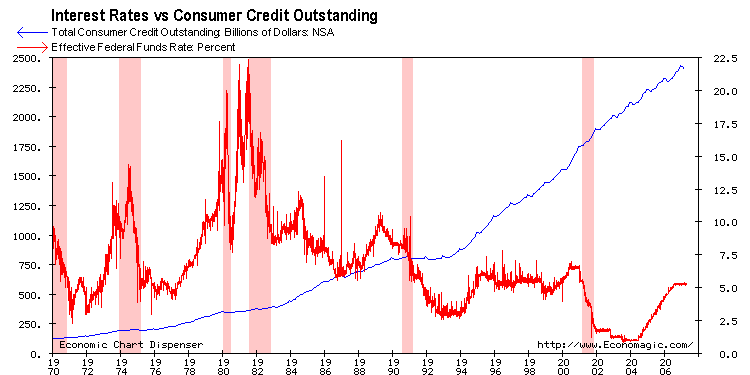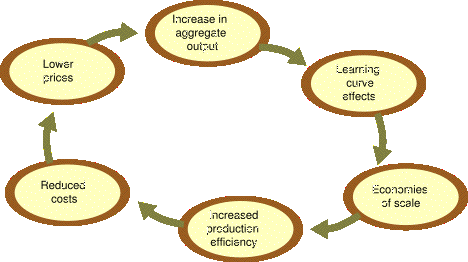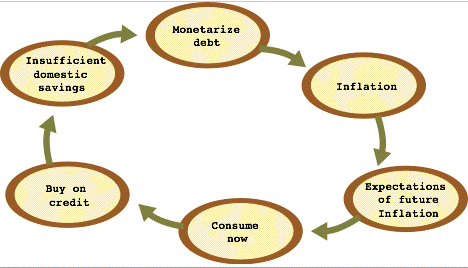 |
Implications of a righting of the US consumer lending system
by Eric Janszen - April 11, 2007
James Scurlock's book and movie "Maxed Out" appears to be about over-indebted Americans. That is in fact what the Wharton Business School graduate set out to discover, he told us in an interview this week. What he found instead during six months traveling the nation was an out-of-control lending system, causing more than half of Americans to take on debts they cannot repay, leaving a wake of financial and personal destruction. The system is driven by the rational behavior of economic actors: lenders in desperate competition with each other for loans, customers, and profits; consumers taking as much cash as they are allowed to borrow; and regulators asleep at the switch. The system is running to its grim, logical conclusion.
This happened not as a conspiracy but by various parties in the system acting in their perceived economic interest. To understand how this came about, for the uninitiated, a brief and ultra-simplified primer on lenders.
A loan is a debt on your balance sheet, but it's an asset on a lender's balance sheet, representing an income stream from the difference between the monthly payments the borrower makes to the lender and the cost of the money that the lender borrowed from the Fed or the credit markets. Think of a loan as a product, like a TV. The lender buys the TV (loan from the Fed, which becomes the lender's capital), repackages it and rents it to the buyer (borrower), who signs a rental contract (such as a mortgage) that says he'll pay rent to the lender once per month (the monthly mortgage loan payment) for 30 years, after which he owns the TV (house).
Just like any other business, lenders need to constantly increase the sales of products (loans), so that the company grows, so that the stock price goes up.
Banks make money by borrowing at a low rate of interest, say, 4%, and lending out at a higher rate, say, a fixed rate mortgage of 6.5%. The higher the spread, the greater the profit. The rate of interest banks pay is set by the Fed and the credit markets. The rate consumers pay depends on their credit rating–the worse the credit rating, the more the borrower pays in interest to cover the bank's risk that the borrower might default.
The economic logic of lending to people with bad credit, then, is simple: the more people with bad credit the better, to a point, because banks can charge a higher rate of interest. Some of the loans will default, of course. But enough borrowers will make the minimum payments on their debts at high interest rates that the sum profits of all of the loans in the bank's portfolio is high.
However, if a lender has too many loans that do not get repaid, then the lender can become insolvent, that is, the capital the bank has to lend is insufficient to meet legal requirements. A sub-prime lender is a lender that specializes in making loans to people with less than prime (good) or "sub-prime" credit. This business is highly profitable because banks can lend money at higher interest rates to sub-prime borrowers. But the business is also more risky, because default rates are higher. If the economy turns down, incomes fall and defaults rise. As the US economy slows, as of this writing, 54 sub-prime lenders have gone under since the sub-prime mortgage lending crisis started.
How about the prime lenders? Evidence is mounting that these lenders are getting into trouble, too. Why? Because, according to James Scurlock, people with good credit were sold the riskiest loans of all, such as interest-only, no money down, stated income or "liar loans," for which the borrower, usually with the knowledge of the originator, exaggerates their income to qualify for the loan. James' research shows that approximately 50% of loans made in California in 2006 were liar loans. Further, as CEO of Dynamic Credit Jim Finkel explained to us in March, credit scores are regularly gamed, so many the buyers of these loans may not really have such good credit after all.
According to the FBI, "People need to understand that any false statement made to a lender or false document presented or prepared is mortgage fraud and that's a federal crime." Maybe liar loans should be renamed "felony loans."
 |
As James explains in his book, falling interest rates in the 1980s started to turn the credit system upside down. Low interest rates meant that lenders could borrow at low rates, but expectations of high interest rates among consumers meant lenders didn't have to lower the rates on their loans to borrowers. The spread produced a huge profit opportunity. The profit opportunity attracted many new lenders to the market. As competition increased, loan creativity increased as well. The loan products became highly complex, and lenders went after more naive customers, such as high school students and elderly people on fixed incomes. James recounts in his book how Harvard law professor Elizabeth Warren asked her law students to explain a mortgage contract they were given and they could not. Any wonder why the average homeowner didn't know what they were getting into when they bought a interest-only liar loans?
The period before and after interest rates fell in the early 1980s divides consumer banking into two distinct periods, the "Right Side Up" period and the "Upside Down" period.
Right Side Up Signs
- Borrowers pursue lenders for loans
- Lenders mail a few million credit card solicitations per year to only the most credit-worthy borrowers
- Lenders prefer credit-worthy borrowers
- Borrowers who do not repay are "deadbeats"
- A mortgage is a debt
- A house is a place to live
- Revolving credit is used to finance major purchases, such as autos
- Banks don't need to be given specific guidance by the FDIC "To make reasonable efforts to determine a borrower's income"
- Lenders pursue borrowers
- Lenders mail more than 4 billion credit card solicitations per year, often to the least credit-worthy borrowers
- Lenders prefer borrowers with poor credit
- Borrowers who repay are "deadbeats"
- A mortgage is "wealth"
- A house is an "investment"
- Revolving credit is used to finance all purchases, such as food and clothing
- Banks need to be given specific guidance by the FDIC "To make reasonable efforts to determine a borrower's income"
You will know the coast is clear when Upside Down becomes Right Side Up again: borrowers pursue lenders, not the other way around; borrowers who do not repay are "deadbeats" not those who do repay; lenders prefer credit-worthy borrowers versus deadbeats; and so on.
What will cause the flip to Right Side Up?
In a word: unemployment. Housing prices are strongly correlated to unemployment, as this FDIC report shows.
 |
James believes the transition back to Right Side Up will be rapid and catastrophic, taking only a couple of years. After studying this problem for over seven years, I stand by my prediction that the transition will be a slow and catastrophic process, taking a decade or more, much as the Japanese post-bubble period lasted, because the government will get involved to manage the transition. The difference is, whereas Japan's post-bubble period was deflationary, the US period will be inflationary.
Although we disagree on the duration of the time it takes to get from Upside Down to Right Side Up, James and I agree that a major financial crash is inevitable, which puts him in the same camp as Dr. Hudson and Rick Ackerman.
 |
What will trigger it? I asked James in Part II if he thinks the FDIC and Fed were unaware of the problems he found or were aware and knowingly allowed this credit bubble to occur. After pausing a moment he said, "They're not stupid. I believe they are corrupt."
Market inefficiencies caused by corruption will be the root cause of the financial panic I expect. The crash will be triggered by the usual source, a revelation of fraud that exposes the corruption. The most likely ground zero? The GSEs. At some point, perhaps soon, a major fraud will be revealed there. This will cause an epiphany among mortgage securities investors that most of the value they perceived is non-existent. A panic ensues as investors try to unload their securities before the entire market becomes aware of the true value of what they are holding. The fear will spread to other markets, such as the over-valued stock market.
Much of what we discuss here at iTulip is about what happens after the smoke clears. My money is still on a reversal of the virtuous circle to become a vicious circle.

In my interview with James this week (again, Part I is available here), James is as methodical and deliberate in his speech as he was at collecting and reporting what he discovered from his six months spent traveling the country. That made it all the more chilling.
iTulip Select interviews are typically divided into two parts. Part I is designed to reveal "What it is," that is, states the problem. In the case of Part I of the James Scurlock interview, James reveals how Upside Down credit came about.
iTulip Select Part II explains "What it means." In Part I of the James Scurlock gives us his take on how we get to Right Side Up.
I strongly recommend James' well researched and written book Maxed Out: Hard Times, Easy Credit and the Era of Predatory Lenders
__________________________________________________
Special iTulip discounted subscription and pay services:
For a book that explains iTulip concepts in simple terms see americasbubbleeconomy
For a macro-economic and geopolitical View from Europe see Europe LEAP/2020
For macro-economic and geopolitical currency ETF advisory services see Crooks on Currencies
For macro-economic and geopolitical currency options advisory services see Crooks Currency Options
For the safest, lowest cost way to buy and trade gold, see The Bullionvault
To receive the iTulip Newsletter or iTulip Alerts, Join our FREE Email Mailing List
Copyright © iTulip, Inc. 1998 - 2007 All Rights Reserved
All information provided "as is" for informational purposes only, not intended for trading purposes or advice. Nothing appearing on this website should be considered a recommendation to buy or to sell any security or related financial instrument. iTulip, Inc. is not liable for any informational errors, incompleteness, or delays, or for any actions taken in reliance on information contained herein. Full Disclaimer

Comment